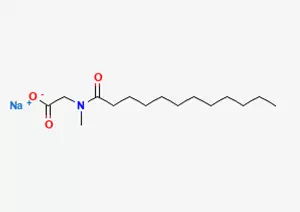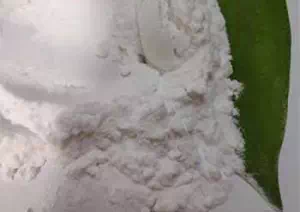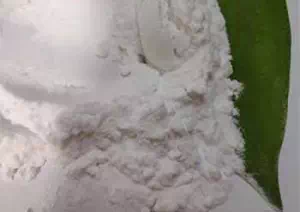Sodium Lauroylsarcosinate Information
Chemical Name | Sodium Lauroylsarcosinate |
Other Name | Sodiumlauroylsarcosinate; N-methyl-n-(1-oxododecyl)glycine sodium salt; Sodium lauroyl sarcosinate |
CAS | 137-16-6 |
EINECS | 205-281-5 |
Type | Food additives; Pharmaceutical raw materials; Organic raw materials; Cosmetic raw materials; Pharmaceutical, pesticide, dye intermediates |
Molecular Formula | C15H28NO3.Na |
Molecular Weight | 293.38 |

Sodium Lauroylsarcosinate Properties
Melting point | 46 °C |
density | 1.033 g/mL at 20 °C |
vapor pressure | 0.02 hPa (20 °C) |
RTECS | MC0598960 |
Fp | 267℃ |
storage temp. | room temp |
solubility | H2O: 1 M at 20 °C, clear, colorless |
form | Powder |
Specific Gravity | 1.03 (20/4℃) |
color | White |
PH | 7.0-9.0 (25℃, 1M in H2O) |
Water Solubility | Soluble in water (293 g/L). |
Sensitive | Hygroscopic |
λmax | λ: 260 nm Amax: 0.2
λ: 280 nm Amax: 0.06 |
Stability | Stable. Incompatible with strong oxidizing agents. |
What is Sodium Lauroylsarcosinate?
Sodium lauryl creatine, also known as sodium lauryl creatine, is also called sodium lauryl-N-methylglycine. This ingredient plays a significant role in cosmetics and skin care products. Its main functions include antistatic properties, providing good foam support effects, and being widely used as an effective surfactant. Its threat coefficient is 3, which means it is very safe and consumers can use products containing this ingredient with peace of mind. It is particularly worth mentioning that for pregnant women, sodium lauryl inositine usually does not cause any adverse effects. In addition, sodium lauryl inositine glutamate also has the advantage of being less likely to cause acne. The U.S. Food and Drug Administration (FDA) has approved sodium lauryl creatine as a safe ingredient to be directly added to food. The Cosmetic Ingredient Review Expert Committee (CIR) allows its application in cleaning products and residue products, but it should be noted that the concentration must not exceed 5%.
Sodium dodecyl sarcosine is a liquid substance that appears white to light yellow in appearance and has a unique odor. This chemical substance can dissolve well in water and also blend with organic solvents such as ethanol or glycerol. At normal temperature, it shows strong stability to heat, acid and alkali. Because it has low skin irritation and relatively mild oil-removing ability, it is very suitable for people with sensitive skin to use. In a wide variety of cosmetics and personal care products, sodium dodecyl creatine is often used as a fungicide, one of the raw materials for soap, a fungicide, an antibacterial agent, and an emulsifier, among other functional additives. It helps prevent tooth decay in toothpaste formulas. As an amino acid-based surfactant, in addition to its excellent cleaning performance, it also has multiple advantages such as antibacterial and disinfectant packaging materials, prevention of metal corrosion, and promotion of biodegradation, making its application in facial cleansers and other beauty and skin care products extremely common. In addition, it has broad application prospects in food processing, beverage production, rust prevention treatment of precision machinery, mineral separation and purification processes, as well as in the medical and health field.

Sodium Lauroylsarcosinate Uses
Sodium lauryl creatine (also known as N-lauryl creatine salt) is an anionic amino acid surfactant with a variety of excellent properties. It is not only widely applied in fields such as daily chemicals, food, and flavor processing, but also demonstrates unique value in biochemical exploration.
Firstly, in terms of its basic properties, sodium lauryl inositine has the characteristics of low toxicity and low annoyance, which means that under normal usage conditions, it poses minimal harm to the human body and the environment. Meanwhile, it also has good biodegradability and can be decomposed by microorganisms in a short time, reducing pollution to the environment. In addition, it has good affinity and can form stable mixtures with various substances, which provides strong support for its application in various fields.
In the field of daily chemicals, sodium lauryl inositine is often added to soaps, body wets, facial cleansers and shaving products. As a surfactant, it can reduce the surface tension of water, making it easier for water to penetrate the skin surface and thereby enhancing the cleansing effect. Meanwhile, it also has a certain antibacterial effect and can help protect the skin from bacterial invasion.
In the food industry, sodium lauryl inositine also plays an important role. It can be used as an emulsifier, stabilizer and thickener, etc., to improve the taste and texture of food. In addition, due to its excellent biodegradability and safety, it is also widely used in the field of flavor processing.
In addition to the above-mentioned application fields, sodium lauryl inositine has also demonstrated unique value in biochemical exploration. For instance, relevant scholars have discovered that it can act as an insulating agent for RNA and DNA, helping to protect these biological macromolecules from external interference. Meanwhile, it can also serve as a lysis agent for cell sanctification, helping researchers better study the structure and function of cells. In addition, by adding this product, the nitrogen-fixing capacity of leguminous rhizobia can also be enhanced, which is of great significance to agricultural production.
In the field of immunochemistry, sodium lauryl inositine also plays an important role. For instance, it can serve as a accumulator for DNA separation, assisting researchers in extracting pure DNA from complex biological samples. These applications not only promote the development of scientific research, but also contribute to human health and social progress.
It is worth mentioning that in order to ensure the quality and safety of sodium lauryl inositine, relevant scholars have also established a logical system for determining its content by gas chromatography. This method takes dodecaenoic acid as the internal standard and forms a methyl ester emulsion after reacting with a methanol solution of boron trifluoride. Separation and purification were carried out through the HP-5 chromatographic column, and detection and quantitative analysis were performed using the FID sensor. The establishment and improvement of this logical system have provided strong technical support and guarantee for the production and application of sodium lauryl inositine.




